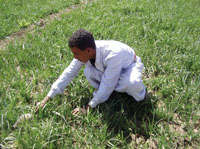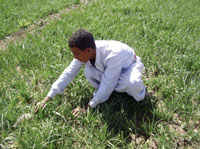
Healthy environment means healthy generations [Archives:2008/1198/Health]
October 13 2008
 |
[email protected]
More than 33 percent of diseases in children under age 5 are caused by environmental exposure, the World Health Organization reported last year, estimating that more than three million children under age 5 die each year due to environment-related causes and conditions. This makes the environment one of the most critical contributors in the annual global death toll of more than 10 million children – as well as an extremely important factor in the health and well-being of their mothers.
Although children under age 15 comprise 46 percent of Yemen's 21 million population, there's no scientific study linking the environment and the spread of diseases in Yemen, particularly among children. However, many doctors and reports have pointed to the relationship between children and the difficult environmental circumstances in which they live.
Fatal diseases and contaminated water
Contaminated water causes diseases such as malaria, diarrhea, polio, typhoid, hepatitis, cholera and bilharzias, which are very common in Yemeni children living in villages and the countryside where residents are forced to use unsafe surface water for drinking.
A parliamentary report exposed that 55,000 Yemeni children die annually due to water pollution-related diseases. The report, which warned of the spread of contaminated water usage, confirmed that 50 percent of child deaths are due to water pollution, including 20 percent from diarrhea and 30 percent from malaria and typhoid.
An Environmental Protection Authority report confirmed that most of these deaths occur among rural inhabitants, who represent 77 percent of Yemen's population.
Water pollution has many causes; however, the National Water Sector Strategy Investment Program, reporting on 2000 through 2003, insisted that the main reason for water pollution in Yemen is absence of safe water sanitation services. The report indicated that only 25 percent of the rural population has access to safe water and only 20 percent have access to safe sanitation, as opposed to 47 percent of urban regions able to access safe water sources and 25 percent with adequate sanitation services.
According to the program, many citizens use unsafe methods to get rid of waste, whether human or water waste, which leaks into the ground. This behavior, the report said, damages groundwater – Yemen's main water source – as well as creating a suitable atmosphere for disease vectors.
Farm children exposed to pesticides
An unofficial study estimates that 624,000 children are working in Yemen, 292,000 of whom work in the agricultural sector, among which 97 percent receive no money for their labor because they work for their own families. Only three percent of such children earn “trivial amounts.” Fifty-five percent of working Yemeni children work in agriculture and crafts, while the rest work as vendors in public places.
An official field study conducted by a Ministry of Social Affairs and Labor team exposed that children working in Yemen's agricultural sector suffer numerous infections and diseases. Covering Sana'a, Al-Beidha and Dhamar governorates, the study found that 45 percent of such children have dermatitis, 30 percent have ophthalmia, which can develop into blindness, 20 percent have intestinal diseases and 5 percent have epilepsy.
The study attributed the reason for such diseases to misuse of herbicides and insecticides because many children, 56 of whom are between ages 8 and 10, don't use protective measures while spraying plants. They mistakenly confuse such poisons with water without consulting the instructions written on the containers. Most children working in the fields tend to work quickly without paying attention; thus, some parts of their neck and shoulders are exposed to the chemicals and their skin receives chemical burns.
Additionally, direct and constant exposure to dust also makes children an easy target for respiratory diseases like asthma and allergies. According to the study, 90 percent of children in these regions also chew qat that's been polluted by herbicides.
Street children exposed to airborne germs
There are no specific statistics for street children in Yemen and estimates vary enormously. Although street children run businesses to support their families, they still suffer society's condescending behavior and are treated as beggars or delinquents. The Higher Council for Motherhood and Childhood defines them as street children due to the shame involved in admitting this group's existence and absence of specific provisions for “street children” in Yemen's legal framework.
The most recent UNICEF study in 2000 estimated 28,789 such children in Sana'a, most of whom are between ages 12 and 14, with the vast majority, 78 to 96 percent, being boys.
UNICEF confirms that street children are among the most physically visible of all children, living and working on streets and in public squares. Yet, paradoxically, they also are among the most invisible and therefore, the hardest to reach with vital services like education and health care, as well as the most difficult to protect.
Medical experts say children in these circumstances are exposed to infection and disease more than adults. “Children who work in the street mainly are subjected to skin diseases, respiratory diseases and sexually transmitted diseases,” pediatrician Dr. Mohammed Kashnoon noted.
Due to the absence of personal cleanliness and prevailing unsanitary conditions, most street children suffer scabies, chicken pox, measles and other infectious illnesses transmitted via direct or indirect contact, according to Kashnoon. “These children also are subjected to respiratory diseases like sore throat, pneumonia, bronchitis and tonsillitis, which may lead to meningitis,” he confirmed.
Most of these diseases are transmitted by air; that is, if an infected individual coughs, his bacteria-contaminated breath is transmitted by air to other children who spend most of their time on the streets.
He also referred to injuries caused by widespread traffic accidents, with the main victims being street children.
Environmental hazards affect fetuses
On numerous occasions, Yemeni doctors have warned about the increased impact of air pollution, which is obvious in major cities like Sana'a, Aden, Taiz and Hodeidah, due to activities such as burning fossil fuels like gas, coal and oil to power industrial processes and motor vehicles. Among harmful chemicals such burning releases into the atmosphere are carbon dioxide, carbon monoxide, nitrogen oxides, sulfur dioxide and tiny solid particles, including lead from gasoline additives.
Al-Thawra General Hospital Deputy Zaid Ahmed Atif warned of air pollution, emphasizing the lead risk for children.
“The danger of lead is its ability to cross barriers and cause strokes and other neurological diseases, especially in children. Lead also raises the rate of physical and mental underdevelopment and its deposit in the liver leads to various diseases, as well as increases respiratory diseases like asthma, which is the lungs' inability to absorb enough oxygen, thus corrupting the bronchioles,” Atif noted.
“A scientific study shows that children's ability to absorb pollutants is higher than the elderly,” he noted.
The WHO report pointed out that health-damaging exposure to environmental risks can begin before birth. “Lead in the air, mercury in food and other chemicals can result in long-term, often irreversible effects, such as infertility, miscarriage and birth defects. Women's exposure to pesticides, solvents and persistent organic pollutants potentially may affect the health of the fetus.
“Additionally, while the overall benefits of breastfeeding are recognized, a newborn's health may be affected by high levels of contaminants in breast milk. Small children whose bodies are developing rapidly are particularly susceptible and in some instances, the health impacts may emerge only later in life.
“Furthermore, children as young as age 5 sometimes work in hazardous settings. Pregnant women living and working in hazardous environments and poor mothers and their children are at a higher risk because they're exposed to the most degraded environments, they're often unaware of the health implications and they lack access to information on potential solutions,” the report said.
Yemen's maternal and infant mortality rates are among the world's highest. In the 2003 demographic survey, an estimated 366 women died for every 100,000 babies delivered, while the infant mortality rate is estimated at 157 deaths for every 1,000 male and female births.
WHO stressed that promoting a healthy environment is partly about assessing, correcting, controlling and mitigating environmental factors that can adversely affect the health of present and future generations.
“In order to achieve this goal, it's important for decision-makers at international, regional and national levels, together with non-governmental organizations, communities and families, to join efforts in recognizing and addressing key environmental hazards. This may include policy action, advocacy, prevention and grassroots participation,” the WHO report advised.
——
[archive-e:1198-v:16-y:2008-d:2008-10-13-p:health]


